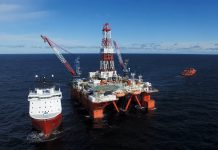In line with its focus on continuous improvement of its cloud-based SeaNavigator voyage-optimization solution, Weathernews Inc recently launched two new integrated AI tools — the Berth Waiting Forecast for vessel operators and New Tonnage Finder for charterers — at a recent customer networking event in Copenhagen.
Leveraging AI predictive data for enhanced voyage efficiency and emissions reduction, the Berth Waiting Forecast enables customers to address the challenge of port delays resulting from adverse weather disrupting cargo handling. Providing real-time ship status and congestion forecasts up to one week ahead, the tool integrates AIS data from 70,000-plus ships, weather data, as well as historical delay comparisons and trends to support users in optimizing voyage plans and adjust speed, thereby reducing fuel burn and CO2 emissions.

Waiting time is identified by analyzing vessels clustered within Weathernews’ predefined port boundaries, and calculated from average weekly values over the preceding month. The map zoom function provides a detailed visualization of vessels in the area. The tool also provides historical reference (the count of vessels in the past month) along with a forecast of vessels that will likely be on standby in the target area in the following week — by day and time of the day.
Forecasts are estimated based on historical waiting trends, past weather observations and future weather forecasts. Designed specifically for charterers to improve revenue by identifying best-performing vessels using real-time data and advanced ship-performance models, the tool leverages AIS data combined with global weather and hydrographic data and ship-performance models. The calculation methodology uses four key parameters: good weather average speed; good weather current factor; good weather performance speed; and good weather fuel consumption. Average speed from AIS data is extracted from set periods in which conditions comply with the good weather definition, and combined with direction and speed corresponding to the current AIS position.
The current factor is then calculated based on the relative direction of the vessel’s heading and current direction. This is subtracted from the average speed to give the vessel’s performance speed, while an Al model estimates fuel consumption based on individual vessel characteristics and its calculated average speed. “Meanwhile, operational risks due to more extreme weather events will require enhanced risk profile, advanced and revised modelling and real-time notification procedures to act proactively rather than reactively – in order to secure lives and assets,” West concluded.
“These two new tools further enhance SeaNavigator where every competitive advantage counts, not only in terms of minimizing logistics risk but also operational costs and environmental impact,” said Niels Christian Kjærgaard, director EU Business Development at Weathernews. “They enhance the already impressive predictive capabilities of the platform, which including the Voyage Planner and CII Simulator represents an end-to-end solution that covers all customer scenarios.”
Weathernews Inc. was founded in 1986 as a service provider supporting safe maritime operations for shipping companies and is today a global leader in weather intelligence, forecasting, route optimization, emission monitoring, performance monitoring, and more. It employs about 1,100 industry professionals and dedicated staff members, all united by the company’s vision to protect, care for, and use the latest technology for its customers worldwide. In addition to a global network of offices, Weathernews also operates two private satellites and several advanced weather radars around the globe.
More info global.weathernews.com



























